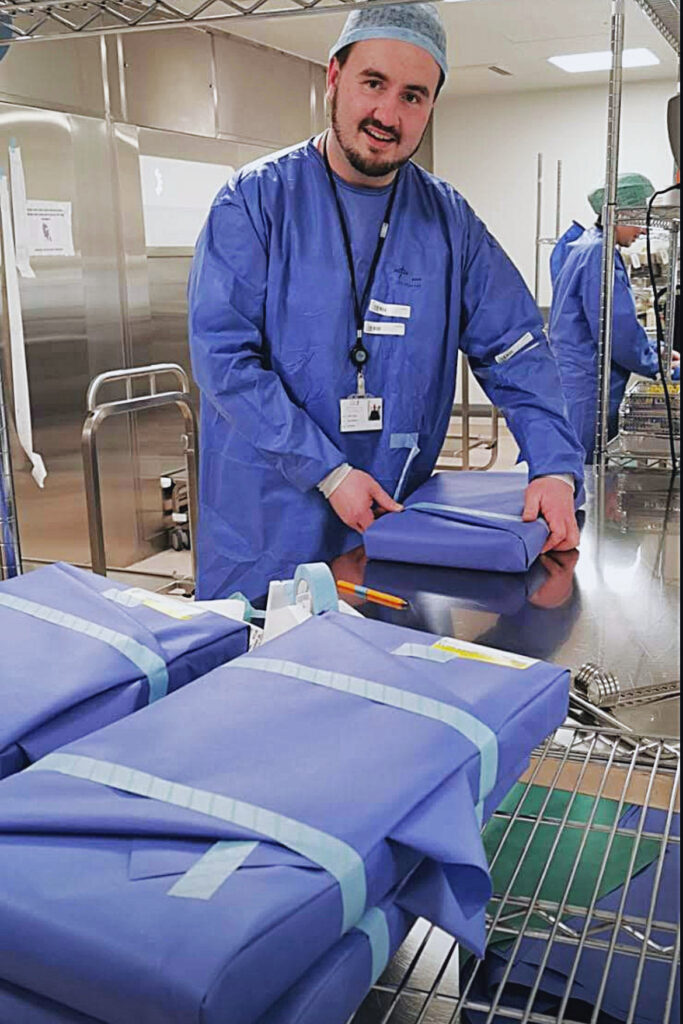
It turns out, good things do come in small packages. One small change can ensure safety and mitigate risks such as sharps injuries for nurses, technicians, and patients alike.
After spending 15 years within sterile processing departments in Ireland, Jamie Dunne developed a deep understanding of how sterile processing departments run. He cheered his department’s successes, and he grew with the failures. He saw what was working and he identified ways that processes could be improved, not only for the sake of patients but for the health and safety of nurses and technicians. Once he identified these gaps, he couldn’t unsee them. He wanted to do something about it.
So, he did.
“I have an awful lot of first-hand experience working in sterile processing for many years. Now, I distribute and educate people on the technology that I used to encounter every day,” said Dunne. “When you’ve done the shifts, when you’ve done the hard work, that’s how you really learn what people need. Once you know that, you can really start to make a difference.”

Dunne now works as a Medical Sales Manager at Inivo Medical Ltd, a medical device distributor based in Ireland. Dunne and Inivo Medical Ltd are not your standard medical supplies team. What Dunne believes sets his work apart is his commitment to education.
“You wouldn’t believe how often I hear, ‘Wow, I never knew that!’ Identifying gaps in knowledge and filling those is huge,” said Dunne. “My goal is not only to make sure people have the correct products for their application and for their unique work environment but that they understand – without a shadow of a doubt – how to use them.”
Reducing Sharps Injuries, Adding Ease to Sterile Instrument Handling
According to Dunne, some of the changes and new products that he has found make the biggest difference are actually rather small. Something as seemingly mundane as updating sterile instrument packaging, for example, can drastically improve patient and technician safety.
“Doing simple things differently with intention can drastically help facilities move towards better compliance, efficiency and make conditions safer for the end user and the patient,” said Dunne.

Both in his own work in sterile processing and in his conversations with other healthcare professionals, Dunne noticed that sharps injuries and near miss incidents (injuries to healthcare professionals due to sharp medical equipment such as surgical scissors, scalpels, or needles) were a problem at many medical institutions. Though sharps injuries can be small on the surface, deadly infections such as human immunodeficiency virus (HIV), hepatitis B or hepatitis C can be passed through this kind of contact. If you have an injury of this sort, you must undergo testing immediately. The wait for the lab results can be excruciating.
Dunne himself has fallen victim to sharps injuries at least four times in his 15-year career as a sterile processing technician. Each time was as terrifying as the first.
Not all anecdotal evidence suggests a widespread problem, but in this case, the statistics support Dunne’s observations. The World Health Organization (WHO) estimates that, “sharps injuries cause about 66,000 HBV, 16,000 HCV and 2,005,000 HIV infections among health-care workers each year.” According to the International Safety Center Exposure Prevention Information Network (EPINet), “approximately 25% of all injuries occur downstream to the non-user (e.g., sterile personnel, clinical team member, EVS personnel, waste hauler, laundry worker, etc.).”
“There’s an awful lot of hazards involved in manually handling surgical instruments,” said Dunne. “Personnel are lifting and shifting all day long and working hard, all the while under constraints like time pressure, workload and spontaneous changes such as the use of loan trays (surgical trays that are borrowed by a hospital for a specific, usually uncommon, procedure). It’s the employer’s responsibility to make sure that everyone has a safe environment to work in.”
This problem loomed over Dunne, just like it looms over many medical professionals. So, when he identified a means of mitigating the prevalence of these injuries, he was overjoyed. True to pattern, the solution was simple: use a hinged instrument protector by SterileBits.

The hinged instrument protector is a protector card that safely holds hinged instruments such as surgical scissors in place during the sterilization and transportation process. Not only does it allow sterilant to reach the maximum amount of surface area possible, it provides a sturdiness to the sterile pouch that safeguards against injury or contamination due to the sharp end perforating the pouch.
“For example,” said Dunne, “If a sterile technician/scrub nurse is presented with surgical scissors in a sterile pouch without a protector card, that person might unintentionally be exposed to a hazard. As the instrument may be processed with the sharp exposed at the aseptic presentation opening. Of course, nobody does that on purpose, but when you’re moving fast and have been working all day, mistakes happen – and there’s much more opportunity for injury when an instrument is loose in a bag.”
On the other hand, if surgical instruments are protected with a backing card, the sharp ends of the instrument are protected and the entire pack itself is more stable, making injury much less likely. The ring-pull technology is also a key factor in removing the instrument safely, while also nearly eliminating the possibility of drops in the Operating Room (OR).
“People are only human. We make mistakes. We just want to make sure everybody has the correct tools so that those mistakes are few and far between,” said Dunne. “It’s a solution that not only affects patients, but also the people who are providing the patients with care.”
Oftentimes, it really is small steps such as this one that lead to great leaps. It just takes the right person to come along and take that first step.
SterileBits: Prioritize Safety
To read more stories similar to this one, visit the SterileBits blog or follow SterileBits on LinkedIn.
To learn more about Inivo and Jamie Dunne, click here.

